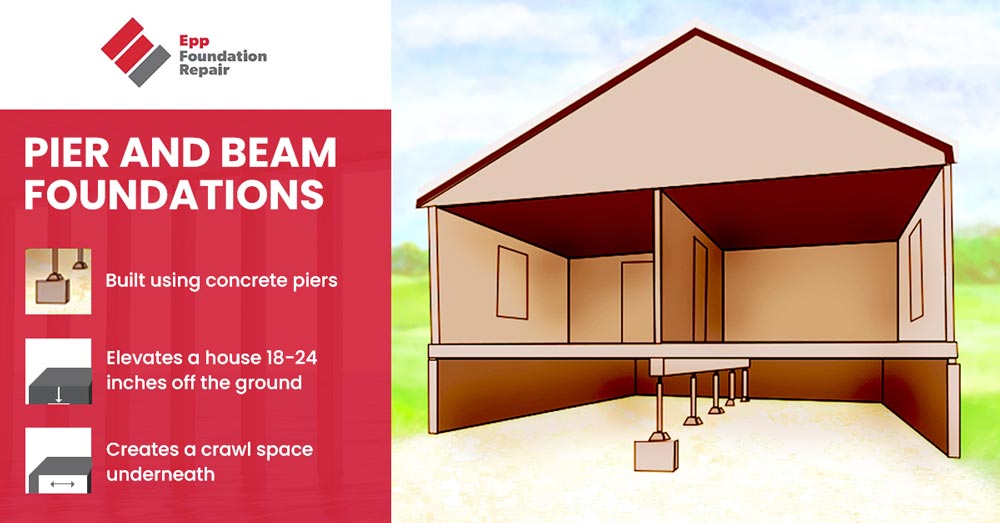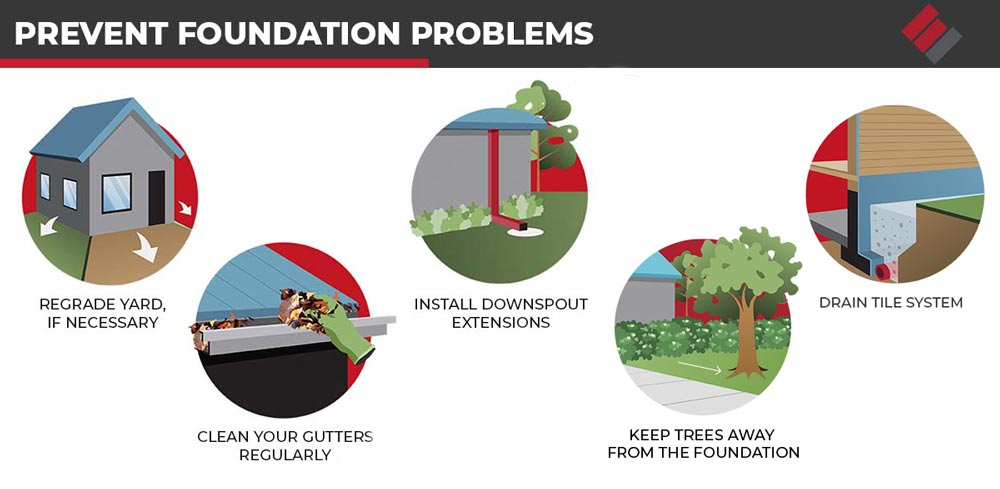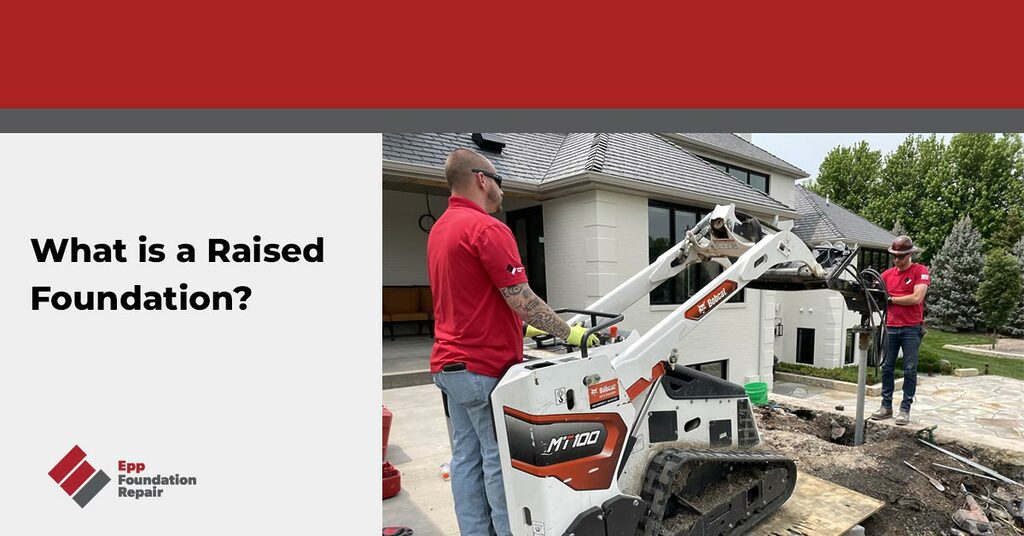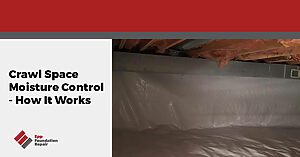Looking for information about raised foundations? If so, we’ve got what you need right here in this article. By the time you’re done reading, you’ll understand raised foundations, including their pros and cons, and possible repair solutions.
What Is a Foundation?
In residential construction, a foundation is the base the building rests on. It is the component that distributes the structure’s weight and ensures stability. A house is prone to sinking, settling, or even collapsing without a strong foundation. Residential foundations come in different types, each of which is designed to suit specific environmental and structural conditions.
What Is a Raised Foundation?
A raised foundation (also called a pier and beam foundation) is a type of structural foundation that is commonly used in areas prone to high moisture levels, unstable soil, or frequent flooding. This construction technique involves elevating the house above ground level on a series of piers or columns rather than directly on a concrete slab. When the area under the house is enclosed with walls, it becomes a crawl space foundation. Raised foundations have been popular for years because they offer easy access to the home’s plumbing, wiring, and HVAC systems.

Other Foundation Types
Slab Foundations
As the name implies, a slab foundation consists of a concrete slab that forms the base for the building. This type of foundation is common in warm climates where frost heave is not an issue. The slab is poured directly on the ground, and the edges are thickened to provide additional support. Slab foundations are relatively inexpensive and straightforward to construct, making them popular with builders.
Basement Foundations
Basement foundations consist of walls and footings that form an underground level beneath the house. This type of foundation is common in areas with cold climates, where insulation and protection against frost heave are necessary. Basements provide additional living space and storage areas.
Pros of a Raised Foundation
A raised foundation offers several advantages to property owners, including the following:
Easy Access to the Home’s Utilities
Raised foundations allow easy access to plumbing, electrical, and HVAC systems, which can be installed and maintained beneath the house.
Protection Against Flooding
Raised foundations provide better protection against floods and soil instability, as the structure is lifted off the ground and supported by piers.
Free Storage
An encapsulated crawl space can be used to store things like tools and holiday decorations.
Cons of a Raised Foundation
While raised foundations are popular in many regions due to their cost-effectiveness and ability to provide elevated support for buildings in flood-prone areas, they come with their own cons. These include:
Susceptible to Damage from Moisture and Pests
One of the most significant drawbacks of raised foundations is that they can be susceptible to damage from moisture and pests. The air circulation beneath the foundation can create a damp environment that is conducive to mold growth, wood rot, and pest infestations, including termites and rodents.
Can Be Less Energy Efficient
A raised foundation can be less energy efficient than a full basement or slab foundation. The gap between the house and the ground allows air to seep in, leading to higher heating and cooling costs.
May Require More Maintenance
Because it is an open space, a raised foundation may require frequent inspections and repairs to ensure that it remains structurally sound.
Poor Construction
Poorly-constructed raised foundations can result in inadequate support for the home. This can lead to sagging floors, cracks in the walls and ceiling, and other problems that require expensive repairs.
Common Repair Solutions for Raised Foundations
The chosen repair solution for a raised foundation will depend, of course, on the nature of the problem. If the foundation is experiencing differential settlement (when a foundation settles into the ground unevenly), then the usual repair solution will be underpinning using either push or helical piers. Underpinning extends the foundation down to load-bearing soil.
Other repair solutions for raised foundations include repairing or replacing damaged or deteriorated beams, support posts, joists, and other structural components. This may involve removing and replacing the affected parts or adding additional support.
In some cases, raised foundations may also benefit from installing a drain tile system. These systems are designed to manage groundwater that may collect under the foundation, which can lead to various issues, including severe structural damage.
Other common repair solutions for crawl space foundations include encapsulating the crawl space and installing a dehumidifier to keep the area clean and dry.
How to Help Prevent Foundation Problems
While foundation problems are sometimes hard to avoid, there are some things you can do to help prevent them. Note that most of these preventive measures involve controlling groundwater around the foundation. This is because most foundation issues are caused by excess moisture in the soil.

- Regrade the yard around your home – Regrading involves shaping the soil around the home’s foundation to slope away from the house at a 5% to 10% grade. This ensures that water drains away from the foundation instead of pooling around it, which can cause many problems.
- Clean gutters regularly – Gutters that are clogged with leaves and other debris prevent water from draining correctly, and can cause backups that lead to water spilling over the side of the house and soaking the ground around the foundation.
- Use downspout extensions – Downspouts are critical in directing rainwater away from the home’s foundation. However, if downspouts discharge water too close to the foundation, this can cause pooling and eventual foundation damage. Installing downspout extensions that direct water at least 15 feet away from the foundation can help eliminate this problem.
- Keep trees away from the foundation – While trees provide excellent shade, their roots can extend far and wide, leading to soil movement and damage to the foundation. It’s best to plant trees at least 50 feet away from the home and remove any trees that are too close to the foundation.
- Install a drain tile system – As noted above, a drain tile system is effective at keeping the ground around the foundation dry.
If you think that your home might have a foundation issue, contact us today to schedule a foundation evaluation. If we find a problem, we’ll give you a free repair estimate. We serve areas in four states: Nebraska, Iowa, Kansas, and Missouri.







